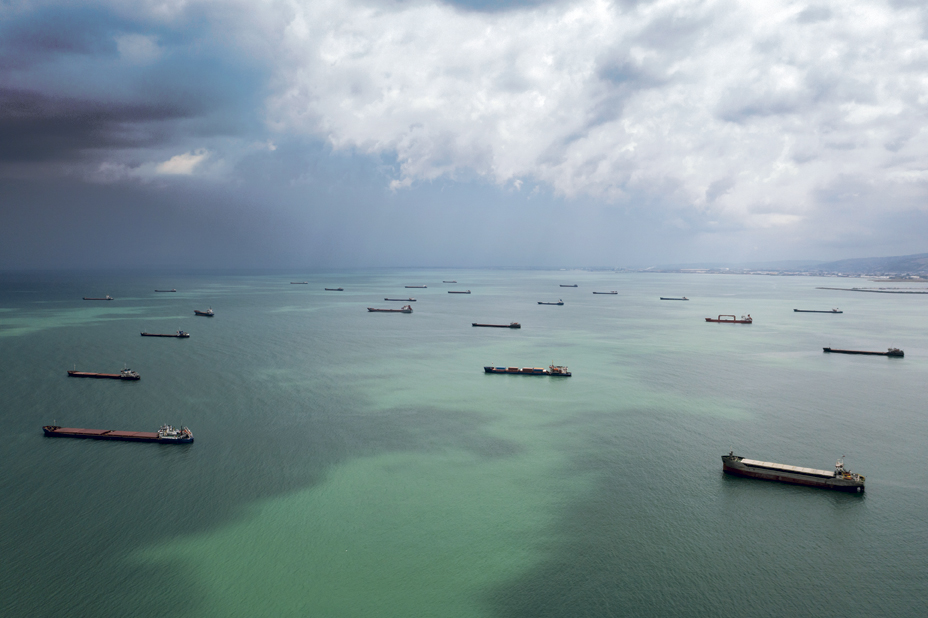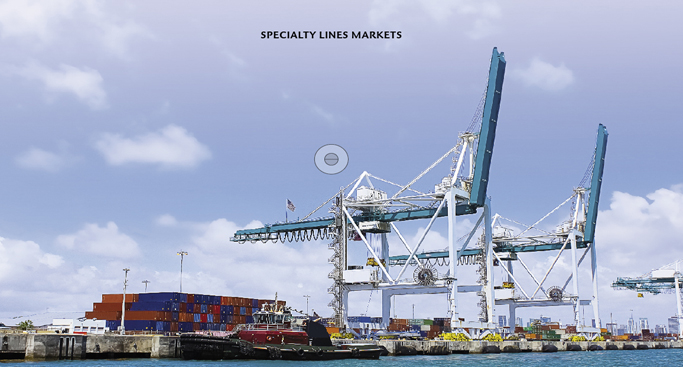FOCUS ON CARGO
Even with emerging risks, the market remains strong
By Lori Widmer
On February 10, 2022, a large cargo ship hauling 4,000 luxury cars caught fire in the Atlantic Ocean. On March 1, the vessel sank, taking with it an estimated $401 million in automobiles.
In 2021, the Ever-Given container ship grounded, blocking the Suez Canal from March 23 to March 29, a six-day window that caused a delay in shipments for over 300 vessels waiting for the canal to clear.
A little over a year later, it happened again. In April 2022, the Ever Forward vessel spent more than a month grounded in the Chesapeake Bay, causing delivery delays for 5,000 containers of product.
Andrew D’Alessio, head of Ocean Cargo, Americas for AXA XL, says it’s been an eventful few years for ocean cargo. “Last year through the first part of 2022—there have been several large and front-page large marine vessel causalities/incidents (Ever Given, Ever Forward, Felicity Ace) that continue to drive severity in losses, as well as the above average wildfire, tornado, and hurricane activity in 2021-22.”

That is the nature of marine cargo exposures, says Bill Rowland, vice president, Ocean Marine, U.S. Insurance, for Sompo International. “There’s always something going on. There’s always a conflict somewhere, there’s always a supply chain issue or a natural catastrophe or a human element that places cargo in harm’s way.”
What is different, says D’Alessio, is that prices continue to climb, which has the potential to amplify the losses. “Inflation and increased product costs have been contributing to more avail-able exposure in general, concentrated on a conveyance, or at a place. While this drives upward movement in the premium base, it can also impact claim frequency and severity. This also creates the need for more limit and risk of aggregation in a container, on a vessel, in a terminal, etc., for carriers.”
Market pressures
Those higher freight costs, says D’Alessio, coupled with the cost to ship a container that he says is “multiples of what it was a few years ago” is driving claim costs.
Add to that the delays. Since the onset of the pandemic, the cargo industry has been plagued by long waits in port for cargo to be unloaded. Ports on both the east and west coasts of the United States are experiencing delays. In April 2022, more than 600,000 containers were awaiting unloading, according to a tweet from Marine Traffic, a global ship-tracking intelligence service.
Those delays can often mean a total loss of cargo. “Perishable good spoilage and/or temperature sensitivity concerns have been an issue,” D’Alessio says. “Ships on the West Coast are waiting long times for a berth and unloading. Plus, the shipment of containers is often delayed, which increases the likelihood of reefer container problems, failures and deterioration of perishables.”
“There is this very old phrase that still rings true: Cargo at rest is cargo at risk,” says Rowland. “If it’s not moving, it’s going to disappear.”
Not all of that cargo disappears via spoilage. “Theft in the United States continues to be an issue,” says D’Alessio, who says staff shortages in the security industry and police forces could be partly why train yards in Los Angeles and Chicago are seeing increased theft. In a letter to the Los Angeles District Attorney’s office, Union Pacific reported a more than 160% increase in criminal rail theft in Los Angeles County.
Whether through theft or spoilage, cargo loss is something keeping underwriters up at night. “A rising concern for underwriters is the rapid acceleration of cargo value aggregation in ports and at sea,” says Rowland. “It is not unusual for our clients to be shipping cargo aboard vessels that can carry five times more cargo than the largest vessels of little more than a decade ago. When these vessels and their cargo are in distress, they’re very difficult to assist and help out.”
The pandemic, too, continues to put pressure on the industry. Mitchell Knutson, senior underwriter for AmWINS Specialty Logistics Underwriters, says supply chain disruptions are being exacerbated by “ongoing COVID lockdowns, labor shortages and sustained, increased freight rates. In addition to the ongoing issues noted, higher fuel costs (high-lighted by inflationary concerns and the Russian invasion of Ukraine) are piling on additional hurdles for the manufacturing and distribution industries.”
COVID-related issues are impacting the workforce, too. “In some cases, ships’ crews have been stranded on vessels much longer than usual,” says Rowland. “Ships’ crews typically rotate on a set schedule; a COVID outbreak aboard a vessel or quarantine requirements for replacement crews arriving in a foreign country has complicated the crewing process.”

“[S]hips on the West Coast are waiting long times for a berth and unloading. Plus, the shipment of containers is often delayed, which increases the likelihood of reefer container problems, failures and deterioration of perishables.”
—Andrew D’Alessio
Head of Ocean Cargo, Americas
AXA XL
Rowland continues, “Cargo has been traditionally one of the most profitable marine product lines. A protracted soft market ended a little over three years ago ushered in by a contracting marine market in Lloyd’s, and around the globe. We’re coming off a three-year period where rates have been increasing, and terms and conditions have become tighter. Results for the greater market have improved significantly and strategies are beginning to change.”
New market emergence
This has caused what Rowland calls “rate fatigue.” Clients and their brokers, he says, are beginning to push back on rate increases. As a result, “Rate rises are tapering off,” he says. “I’m not saying they’re flat, but the rate curve is certainly leveling off compared to the last three and a half years.”
The U.S. cargo market is emerging from a hard market and a “strong correction” in terms of rates, terms, and conditions, D’Alessio says. “Amongst the carriers there is variation to whom has returned to growth mode and are being more competitive, while some are still correcting their portfolios or working to sustain profitability.”
Knutson describes rates “still inching upwards, however, nearing plateau as a whole. There remains targeted correction by underwriters for volatile commodities and CAT-heavy stock risks; however, there’s an overall deceleration in rate environment compared to this time last year.”

Marine cyber is still in its nascent stages given the lack of credible loss data available. Some markets have created measured solutions, but they’re missing the mark given the lack of a sufficient risk-transfer product at present.”
—Mitchell Knutson
Senior Underwriter
AmWINS Specialty Logistics Underwriters
In terms of new products, marine cyber coverage is beginning to emerge, Knutson says. “However, the offerings are more ‘window dressing’ than a permanent solution.”
A solution is needed, though it may not come from the marine underwriters. “In large, marine insurers and reinsurers have elected to exclude cyber losses, given the large and unknown systemic risk posed,” says D’Alessio. “Carriers are shifting those risks to specialty cyber markets who are better equipped to underwrite these exposures. Some companies do choose to offer coverage via a defined/named perils coverage, sub-limited/aggregated at an additional premium.”
Specialty brokers, he says, are trying to differentiate by requesting new clauses or enhanced coverage options. “Generally, carriers are resisting a shift back to expanding coverage since that was a main driver of the issues carriers faced prior to the hard market,” D’Alessio says. Coverage restrictions Knutson has seen in 2022 tend to be related to the Russian invasion of Ukraine, “where markets have implemented restrictions for shipments to the region.”
Advice for agents and brokers
Agents and brokers who are on top of events across the globe will be better positioned to advise clients on their insurance program, say the experts. “Tapping into the vast amounts of industry knowledge,” says Rowland, can help all parties better understand what evolving and emerging risks need to be addressed. “Clients developing new products, entering new markets or contemplating new modes of transportation will benefit from partnering with experienced underwriters that can craft their coverages solutions to address the unique and evolving landscape in global trade. The pace of change continues to accelerate as we look to the future; near term and further out, there are a lot of things underwriters have to adapt to as we go forward.”
Data will play a large role in understanding those emerging risks, says D’Alessio. “A meaningful contributing factor to carriers’ success during the hard market has been the usage of data and analytics. The ability to slice, segment and analyze a portfolio lets carriers pinpoint opportunistic areas as well as pain points. Data driven underwriting is likely here to stay and augment the processes.”
Another thing that is here to stay is cyber risk. “Marine cyber is still in its nascent stages, given the lack of credible loss data available,” says Knutson. “Some markets have created measured solutions, but they’re missing the mark given the lack of a sufficient risk-transfer product at present.”
Even with the emerging risks, Rowland says that the market is strong. “The cargo market is in a healthy spot right now. Not too many people coming in, not too many going out. The markets that are there have been there for a long time.” That, say the experts, is why the cargo industry remains a viable, lucrative line of business.
For more information:
AmWINS Specialty Logistics Underwriters
www.amwins.com/opco/amwins-specialty-logistics-underwriters
AXA XL
www.axaxl.com
Sompo International
www.sompo-intl.com
The author
Lori Widmer is a Philadelphia-based writer and editor who specializes in insurance and risk management.





